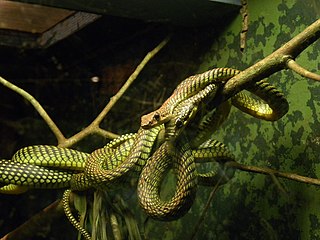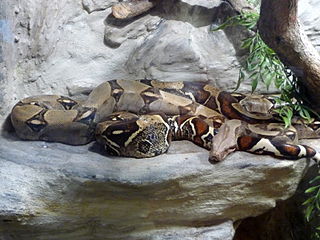
The Pythonidae, commonly known as pythons, are a family of nonvenomous snakes found in Africa, Asia, and Australia. Among its members are some of the largest snakes in the world. Ten genera and 39 species are currently recognized. Being naturally non-venomous, pythons must constrict their prey to suffocate it prior to consumption. Pythons will typically strike at and bite their prey of choice to gain hold of it; they then must use physical strength to constrict their prey, by coiling their muscular bodies around the animal, effectively suffocating it before swallowing whole. This is in stark contrast to venomous snakes such as the rattlesnake, for example, which delivers a swift, venomous bite but releases, waiting as the prey succumbs to envenomation before being consumed. Collectively, the pythons are well-documented and -studied as constrictors, much like other non-venomous snakes, including the boas and even kingsnakes of the New World.

Snakes are elongated, limbless, carnivorous reptiles of the suborder Serpentes. Like all other squamates, snakes are ectothermic, amniote vertebrates covered in overlapping scales. Many species of snakes have skulls with several more joints than their lizard ancestors, enabling them to swallow prey much larger than their heads. To accommodate their narrow bodies, snakes' paired organs appear one in front of the other instead of side by side, and most have only one functional lung. Some species retain a pelvic girdle with a pair of vestigial claws on either side of the cloaca. Lizards have independently evolved elongate bodies without limbs or with greatly reduced limbs at least twenty-five times via convergent evolution, leading to many lineages of legless lizards. These resemble snakes, but several common groups of legless lizards have eyelids and external ears, which snakes lack, although this rule is not universal.

The Boidae, commonly known as boas or boids, are a family of nonvenomous snakes primarily found in the Americas, as well as Africa, Europe, Asia, and some Pacific islands. Boas include some of the world's largest snakes, with the green anaconda of South America being the heaviest and second-longest snake known; in general, adults are medium to large in size, with females usually larger than the males. Six subfamilies comprising 15 genera and 54 species are currently recognized.

Belize is a country with a rich variety of wildlife, due to its unique position between North and South America, and a wide range of climates and habitats for plant and animal life. Belize's low human population, and approximately 8,867 square miles (22,970 km2) of undistributed land, provides an ideal home for more than 5000 species of plants, and vast numbers species of animals — with several hundred vertebrates including armadillos, snakes, and monkeys.

Garter snake is the common name for small to medium-sized snakes belonging to the genus Thamnophis in the family Colubridae. Native to North and Central America, species in the genus Thamnophis can be found in all of the lower 48 United States, and nearly all of the Canadian provinces south of the Northwest Territories and Nunavut—with the exception of Newfoundland and Labrador. They are found from the subarctic plains of west-central Canada east through Ontario and Quebec; from the Maritime Provinces and south to Florida, across the southern and central U.S. into the arid regions of the southwest and Mexico, Guatemala and south to the neotropics and Costa Rica.

The common garter snake is a species of snake in the subfamily Natricinae of the family Colubridae. The species is indigenous to North America and found widely across the continent. There are several recognized subspecies. Most common garter snakes have a pattern of yellow stripes on a black, brown or green background, and their average total length is about 55 cm (22 in), with a maximum total length of about 137 cm (54 in). The average body mass is 150 g (5.3 oz). The common garter snake is the state reptile of Massachusetts.

A snakebite is an injury caused by the bite of a snake, especially a venomous snake. A common sign of a bite from a venomous snake is the presence of two puncture wounds from the animal's fangs. Sometimes venom injection from the bite may occur. This may result in redness, swelling, and severe pain at the area, which may take up to an hour to appear. Vomiting, blurred vision, tingling of the limbs, and sweating may result. Most bites are on the hands, arms, or legs. Fear following a bite is common with symptoms of a racing heart and feeling faint. The venom may cause bleeding, kidney failure, a severe allergic reaction, tissue death around the bite, or breathing problems. Bites may result in the loss of a limb or other chronic problems or even death.

Rectilinear locomotion or rectilinear progression is a mode of locomotion most often associated with snakes. In particular, it is associated with heavy-bodied species such as terrestrial African adders, pythons and boas; however, most snakes are capable of it. It is one of at least five forms of locomotion used by snakes, the others being lateral undulation, sidewinding, concertina movement, and slide-pushing. Unlike all other modes of snake locomotion, which include the snake bending its body, the snake flexes its body only when turning in rectilinear locomotion.

Envenomation is the process by which venom is injected by the bite or sting of a venomous animal.

Chrysopelea, more commonly known as the flying snake or gliding snake is a genus that belongs to the family Colubridae. Flying snakes are mildly venomous, though the venom is dangerous only to their small prey. Their range is in Southeast Asia, southernmost China, India, and Sri Lanka.

Paradise tree snake or paradise flying snake is a species of snake found in southeastern Asia. It can, like all species of its genus Chrysopelea, glide by stretching the body into a flattened strip using its ribs. It is mostly found in moist forests and can cover a horizontal distance of 10 meters or more in a glide from the top of a tree. Slow motion photography shows an undulation of the snake's body in flight while the head remains relatively stable, suggesting controlled flight. They are mildly venomous with rear fangs and also can constrict their prey, which consists of mostly lizards and bats.

The Central African rock python is a species of large constrictor snake in the family Pythonidae. The species is native to sub-Saharan Africa. It is one of 10 living species in the genus Python.

The giant garter snake is the largest species of garter snake. Relatively rare, it is a semi-aquatic snake with a limited distribution in the wetlands of central California.

The ability to sense infrared thermal radiation evolved independently in two different groups of snakes, one consisting of the families Boidae (boas) and Pythonidae (pythons), the other of the family Crotalinae. What is commonly called a pit organ allows these animals to essentially "see" radiant heat at wavelengths between 5 and 30 μm. The more advanced infrared sense of pit vipers allows these animals to strike prey accurately even in the absence of light, and detect warm objects from several meters away. It was previously thought that the organs evolved primarily as prey detectors, but recent evidence suggests that it may also be used in thermoregulation and predator detection, making it a more general-purpose sensory organ than was supposed.

Boa imperator is a large, heavy-bodied, nonvenomous species of snake in the genus Boa that is commonly kept in captivity. Boa imperator is part of the family Boidae and is found in Mexico, Central America and South America west of the Andes Mountains. It is commonly called the Central American boa, northern boa, Colombian boa, common boa and common northern boa.

The western terrestrial garter snake is a western North American species of colubrid snake. At least five subspecies are recognized.
Constrictor may refer to:

The boa constrictor, also known as the common boa, is a species of large, non-venomous, heavy-bodied snake that is frequently kept and bred in captivity. The boa constrictor is a member of the family Boidae. The species is native to tropical South America. A staple of private collections and public displays, its color pattern is highly variable yet distinctive. Four subspecies are recognized.

Boa constrictor occidentalis, also commonly known as the Argentine boa, is a subspecies of large, heavy-bodied, nonvenomous, constricting snake. Boa constrictor occidentalis is a member of the family Boidae, found in the subtropical temperate west of Argentina and Paraguay, although some members have been reported to exist in Bolivia as well.
















